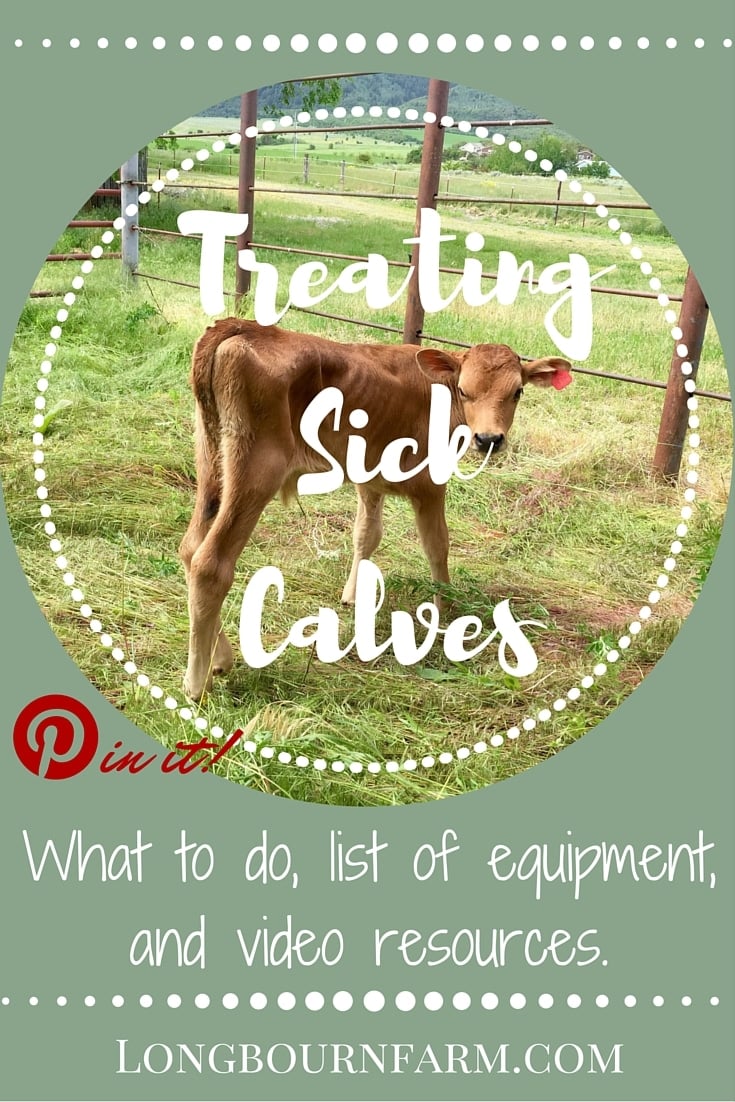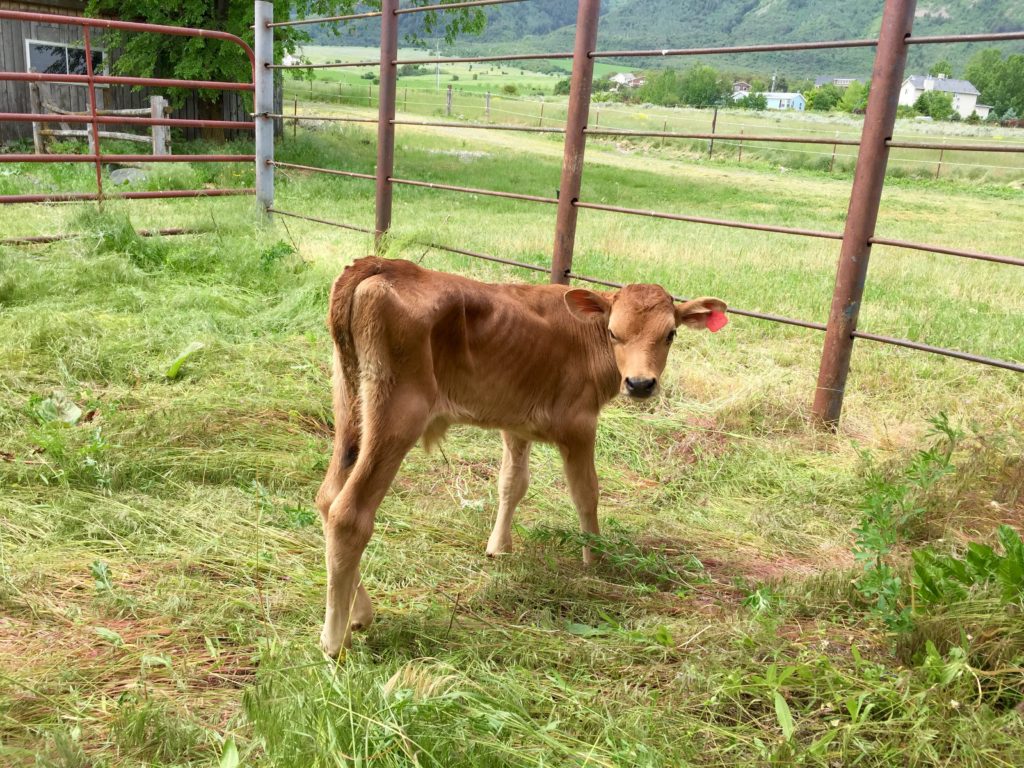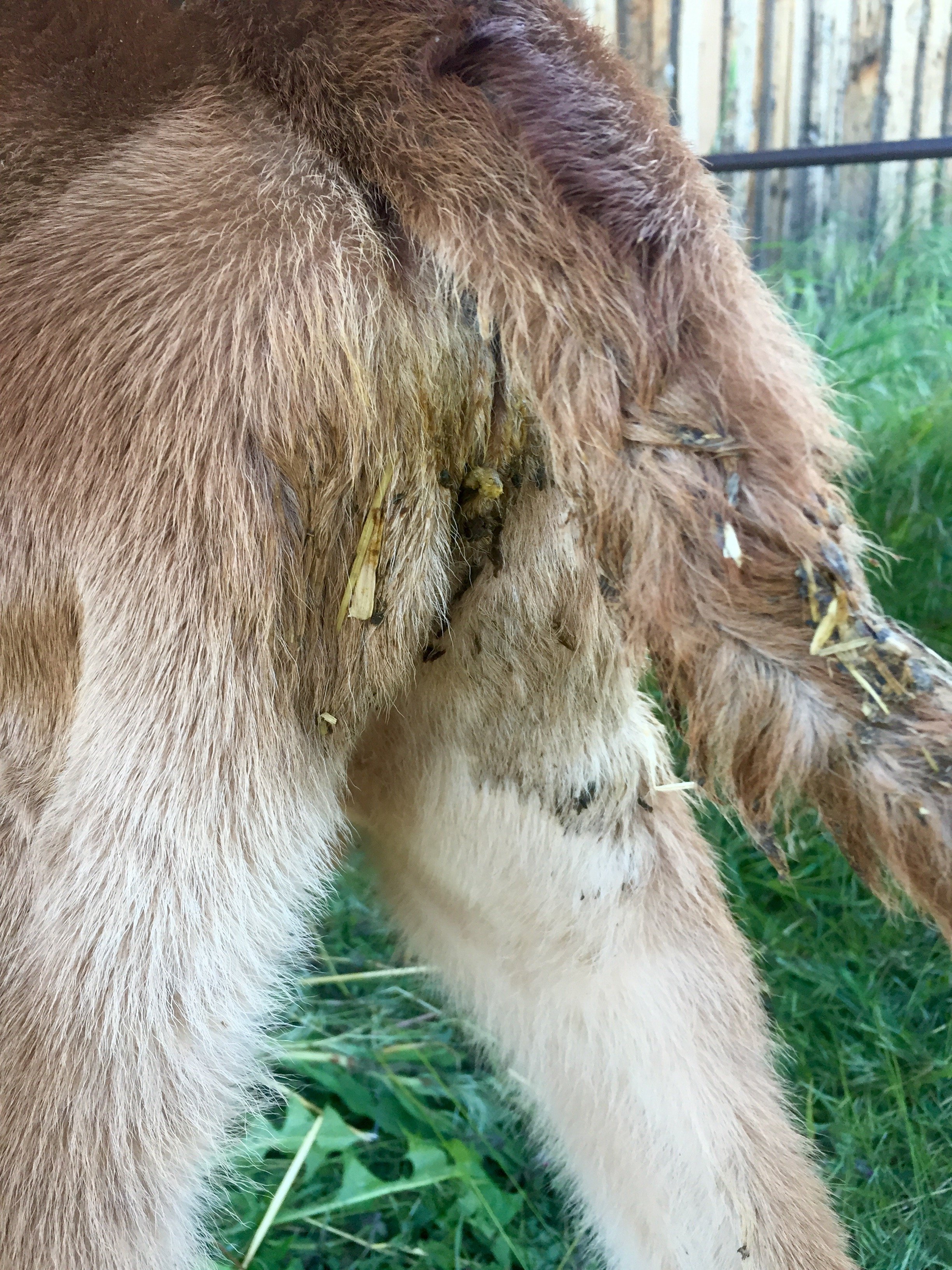Our experience of treating sick calves with scours. Learn what supplies to have on hand, what to do, and what NOT to do to help your calves recover.
A couple of weeks ago, we got a couple of bottle calves. Purchasing bottle calves quickly turned into treating sick calves. This was {not} excellent planning on my part because I got them just a few days before my brothers wedding, which I wrote about more in this post. It wasn’t a good decision because what could possible go wrong when bringing home calves?
Ha. Always my famous last words.
Within a few hours of arriving at my house, the calves both broke with scours. Scours is basically diarrhea {sorry for that visual, but we are all about poop here} and the danger comes from being ill, but also greatly from dehydration. Calves can get dehydrated really easily so prevention and then management is key, otherwise they can die. This was pretty frustrating for me for a couple reasons. First, I basically interrogated the seller to death to make sure the calves were coming to me healthy and have received all the proper care prior to me buying them. Second, I was so cautious and careful to make sure that nothing besides environment was changing for them. Changes can cause stress, which can cause sickness. Third, I already lost a bottle lamb this spring and although there wasn’t anything I could have done, loosing animals makes me feel like a failure.
In the end, I don’t know why they got it, but they did and treatment for scours is pretty standard so I wasn’t too worried. We started treating the sick calves by adding extra electrolyte feedings and an antibiotic regimen. Calf 824 perked right up within 24 hours and never really missed a beat – that’s how it’s supposed to work.
Calf 830, ugh. He seemed to improve immediately as well, but then nosedived 12 hours later and I had to call in a very good friend to come help me. She grew up on a dairy and is basically pro at calf care. We reviewed giving shots {I always like to review with someone who is more experienced than me if it’s an animal or age I’ve never done before} and she showed me how to tube feed the calf. So we did that for a day or two and he improved a little bit, but he wasn’t an enthusiastic patient.
And then we needed to go to wedding festivities for a few days. Ah! Good foresight, Alli.
So, this amazing friend who deserves to be knighted or something, offered to help out and care for the both calves while we were gone. She cared for them like any professional and friend would, and 824 remained healthy, and 830 seemed to improve until last night, when he nosedived – again.
Seriously. It shouldn’t be this hard to get over scours. I asked my friend what she would do and she said she wouldn’t give up on him yet. So, we arrived home with the determination to keep him alive and keep trying. But as we were walking to the barn, I had a bad feeling and I knew something was weird when we opened the door. Poor 830 had decided he was done and passed in the few hours between his last feeding and our arrival home.
As a caretaker, there is only so much you can do with an animal who doesn’t want to fight. And he never really decided he was going to fight. Frustrating, sad and disappointing, but a real part of raising baby animals. In this case, I know I did absolutely everything. I observed them enough to know right when they got sick, I jumped on treatment within hours of the onset of illness, and my friend and I seriously worked to hard to keep that poor baby alive.
Treating Sick Calves
Here is an outline of how to deal with scours. As always, the first thing you should do is call your veterinarian. I didn’t just know what antibiotics to give and where to get them, I called my vet, listened to their recommendations and then went from there by asking for help from people who have more experience than me.
- Observe calves regularly, especially after traveling. Scours and pneumonia are big risks.
- Scours is diarrhea, and there will be no question when they have it. If you can’t see them have it, you will smell it. You can also see it on their little behinds as in the pic below {sorry for that close-up}.
- Call your vet and get the correct antibiotics from them. If you’re not comfortable giving shots and don’t have someone to walk you through it, you can also give pills {you will need a pill gun to do this, we purchased one at Cal-Ranch just in case}. You can wait on administering antibiotics, but honestly jumping on treatment will give them the best chance possible. If you run out of meds and they still aren’t doing well, call your vet for further instructions and/or additional medication.
- You can also supplement their normal milk replacer with milk replacer that has antibiotics in it to help treat scours as well. We did this {thank you awesome neighbors for letting us borrow it} and followed the label instructions {very important!} for how long to continue giving it. Following label instructions reduces the likelihood of you contributing to the bacteria building up antibiotic resistance.
- Purchase electrolyte mix and feed it as often as the label directs for as long as the illness lasts. Tractor Supply near us had the best selection. Even after they recover, continue at least every other day for a few days. This is like calf gatorade and keeps them from getting more dehydrated.
- If you do end up needing to tube feed a calf, you can purchase tube feeders online or we found one at our local Tractor Supply. Have someone with experience show you how to do this. I have done something similar during my master’s project when I had to collect rumen fluid from non-cannulated cows, but calves are always different because they are smaller so I wanted to be shown the first time. If done incorrectly, you can get into the lungs and drown the calf. I also had to show Andy the best way to hold the calf. Get them into a standing position, straddle the calf, place your right hand on the jaw and your left hand on the front of the shoulder so you can keep it standing, keep it still, and also feel the left side of the neck to make sure the tube is in the esophagus {to the stomach}, not the trachea {to the lungs}. Let the milk or electrolyte mix just flow out by gravity {no squeezing!} and feed them 3/4 to 1/2 of what you normally would expect them to eat on their own. If they struggle a lot, you may have to remove the tube and try again. Always stop the flow of any left over fluid and try to remove the tube slowly to avoid getting any in the lungs as you pull it out. Obviously we don’t have video of pictures of any of this, but this video does a great job of demonstrating. It’s about giving colostrum to dairy calves {also helpful}, but the tube feeding is the same.
- With the proper antibiotics and an extra boost from electrolytes, you should be able to help your calf recover within a few days. Ours had an unusually hard time, we aren’t sure why. Never try to determine treatment on your own, always consult a vet for help or recommendations and call a more experienced friend if you need further help.
- The most important thing to remember when doing treating sick calves or doing anything like this with any animal is to remain calm, and take your time. There is no need to be frantic, that helps no one and just makes animals anxious. I know these situations can be stressful, but being calm and collected will always help you get things done more quickly, make better decisions, and help the animal trust you.
Hopefully, you won’t have to deal with treating sick calves – but you should be more prepared than I was and just have some of the equipment on hand if you plan on purchasing bottle calves. Often, raising bottle calves can turn into treating sick calves. Let me know if you have further questions and I’ll find the resources to answer them if I don’t have the answer myself!








Matthew Rollins says
We had 3 nannys to help with the milk it worked also gave antbiotics before we tranported them